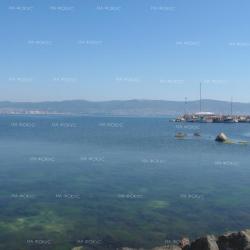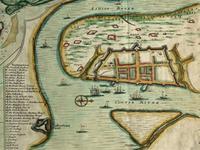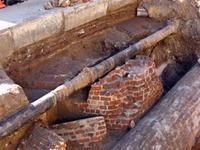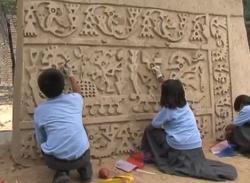INSTITUT SUPERIEUR D'ANTHROPOLOGIE
INSTITUTE OF ANTHROPOLOGY
ONLINE COURSES / COURS A DISTANCE
INSCRIPTION 2012 / Session III : Juillet 2012
REGISTRATION 2012 / Term III : July 2012
BULGARIE –  Chernomorets - Archaeologists with the team of Associate Professor Dr Ivan Hristov, Deputy Director of the National Museum of History, discovered an underwater residential quarter during the excavations at Cape Akin close to the coastal town of Chernomorets. Bozhidar Dimitrov, Director of the National Museum of History, announced the news exclusively for FOCUS News Agency. “During the excavations under the Via Pontica government programme at Cape Akin, one of the three capes of the town of Chernomorets, apart from the massive fortified wall with two battle towers at the peninsula itself, archaeologist Dr Ivan Hristov also discovered a continuation of the fortified wall into the sea. The continuation of the wall surrounds a big shoal Southwest of the cape. The fortified wall is preserved to some big height and the team has seen the outlines of a big battle tower of five meters height and three and a half meters width,” Bozhidar Dimitrov explained. In his words, the archaeologists have already ascertained that this is the early Byzantine fortress Krimna, which was situated there. Due to some circumstances, since the beginning of the WWI until a couple of years ago the fortress was within the area of a military unit and it was impossible for the archaeologists to study it. “The part of the fortress on dry land covers nearly 40 decares. The fortified wall is bigger even than the one in Sozopol – of around 2.6 metres width. The coins found by the archaeologists prove that the wall was built by Anastasius I in around 513, then reinforced by Justinian I over the next decades and probably the settlement was destroyed during the big Avarian invasion in 583-586,” Dimitrov said further. According to Bozhidar Dimitrov, the discovery of an underwater residential quarter is not a surprise. “The discovery of this underwater quarter in one of the coastal towns is so far the sole quarter discovered along the Black Sea coast and it may turn into a wonderful site for cultural and historical tourism under the Via Pontica programme,” Dimitrov remarked.
Chernomorets - Archaeologists with the team of Associate Professor Dr Ivan Hristov, Deputy Director of the National Museum of History, discovered an underwater residential quarter during the excavations at Cape Akin close to the coastal town of Chernomorets. Bozhidar Dimitrov, Director of the National Museum of History, announced the news exclusively for FOCUS News Agency. “During the excavations under the Via Pontica government programme at Cape Akin, one of the three capes of the town of Chernomorets, apart from the massive fortified wall with two battle towers at the peninsula itself, archaeologist Dr Ivan Hristov also discovered a continuation of the fortified wall into the sea. The continuation of the wall surrounds a big shoal Southwest of the cape. The fortified wall is preserved to some big height and the team has seen the outlines of a big battle tower of five meters height and three and a half meters width,” Bozhidar Dimitrov explained. In his words, the archaeologists have already ascertained that this is the early Byzantine fortress Krimna, which was situated there. Due to some circumstances, since the beginning of the WWI until a couple of years ago the fortress was within the area of a military unit and it was impossible for the archaeologists to study it. “The part of the fortress on dry land covers nearly 40 decares. The fortified wall is bigger even than the one in Sozopol – of around 2.6 metres width. The coins found by the archaeologists prove that the wall was built by Anastasius I in around 513, then reinforced by Justinian I over the next decades and probably the settlement was destroyed during the big Avarian invasion in 583-586,” Dimitrov said further. According to Bozhidar Dimitrov, the discovery of an underwater residential quarter is not a surprise. “The discovery of this underwater quarter in one of the coastal towns is so far the sole quarter discovered along the Black Sea coast and it may turn into a wonderful site for cultural and historical tourism under the Via Pontica programme,” Dimitrov remarked.
http://www.focus-fen.net/index.php?id=n281878
USA – 
 Charleston - Portions of Charleston's early wall are now on exhibit in the Lowcountry History Hall at The Charleston Museum. Sections of brick parapet and cypress pilings from the protective palisade were retrieved from the archaeological dig at Tradd Street in 2008 and 2009, conducted by The Charleston Museum and the Walled City Task Force. "The exhibit also includes a cedar piling from Johnson's ravelin, retrieved during the archaeological dig by New South Associates at the Charleston Judical Center in 1999 and palings from the 1745 moat in front of the Half Moon Battery, recovered by The Charleston Museum in 1979," adds Martha Zierden, the Museum's Curator of Historical Archaeology. Sections of the demolished brick parapet were retrieved from the dig and transported to the Museum by Charleston Water Systems. The wooden pilings were also retrieved with the help of Charleston Water Systems, and conserved by the Maryland Archaeological Conservation Laboratory. Charleston, South Carolina was the only English walled city in North America. Fearing assault by the Spanish and French from the water and landward incursions by hostile Native Americans, the Carolina proprietors ordered construction of a brick "curtain wall" along Charleston's waterfront in 1694. Construction began in 1696 and continued for more than a decade, requiring several million bricks, produced at nearby kilns. According to wall historian Katherine Pemberton, the plan was likely developed by professional engineers in England, following the defensive principals espoused by respected 17th century military engineer Sebastien de Vauban. By 1706, the entire town was enclosed within a protective wall. The landward walls, likely of earth, were gradually abandoned, but the impressive brick seawall remained intact through the Revolution. The redan, or triangular projection, at Tradd Street was outfitted with cannon, designed to provide protective cross-fire in the event of attack from the water. In 1784, the defensive works were leveled and the fortified land subdivided, sold, and built over.
Charleston - Portions of Charleston's early wall are now on exhibit in the Lowcountry History Hall at The Charleston Museum. Sections of brick parapet and cypress pilings from the protective palisade were retrieved from the archaeological dig at Tradd Street in 2008 and 2009, conducted by The Charleston Museum and the Walled City Task Force. "The exhibit also includes a cedar piling from Johnson's ravelin, retrieved during the archaeological dig by New South Associates at the Charleston Judical Center in 1999 and palings from the 1745 moat in front of the Half Moon Battery, recovered by The Charleston Museum in 1979," adds Martha Zierden, the Museum's Curator of Historical Archaeology. Sections of the demolished brick parapet were retrieved from the dig and transported to the Museum by Charleston Water Systems. The wooden pilings were also retrieved with the help of Charleston Water Systems, and conserved by the Maryland Archaeological Conservation Laboratory. Charleston, South Carolina was the only English walled city in North America. Fearing assault by the Spanish and French from the water and landward incursions by hostile Native Americans, the Carolina proprietors ordered construction of a brick "curtain wall" along Charleston's waterfront in 1694. Construction began in 1696 and continued for more than a decade, requiring several million bricks, produced at nearby kilns. According to wall historian Katherine Pemberton, the plan was likely developed by professional engineers in England, following the defensive principals espoused by respected 17th century military engineer Sebastien de Vauban. By 1706, the entire town was enclosed within a protective wall. The landward walls, likely of earth, were gradually abandoned, but the impressive brick seawall remained intact through the Revolution. The redan, or triangular projection, at Tradd Street was outfitted with cannon, designed to provide protective cross-fire in the event of attack from the water. In 1784, the defensive works were leveled and the fortified land subdivided, sold, and built over.
http://www2.counton2.com/news/2012/jun/29/17th-century-artifacts-walled-city-dig-permanent-e-ar-4063069/
ROYAUME UNI –  Greenwich - A priceless hoard of Victorian rubbish – including champagne bottles, tennis balls, sports shoes, bowler hats, medicine jars, clay pipes and tobacco tins – has been discovered bricked up under steps leading to the imposing courtyard at the Old Royal Naval College in Greenwich. The haul is so precisely the kind of domestic junk that any untidy householder shoves into a cupboard before an unexpected visitor, that archaeologists wonder if it represents just that, a hasty cleanup before a grand event at a site where royalty were regular visitors. The objects were datable to the 1870s and 80s from labels on the jars and tins, and the dishes for the Royal Naval officers' training college, which was established in 1873 in the magnificent buildings originally designed by Sir Christopher Wren as a hospital for naval pensioners.
Greenwich - A priceless hoard of Victorian rubbish – including champagne bottles, tennis balls, sports shoes, bowler hats, medicine jars, clay pipes and tobacco tins – has been discovered bricked up under steps leading to the imposing courtyard at the Old Royal Naval College in Greenwich. The haul is so precisely the kind of domestic junk that any untidy householder shoves into a cupboard before an unexpected visitor, that archaeologists wonder if it represents just that, a hasty cleanup before a grand event at a site where royalty were regular visitors. The objects were datable to the 1870s and 80s from labels on the jars and tins, and the dishes for the Royal Naval officers' training college, which was established in 1873 in the magnificent buildings originally designed by Sir Christopher Wren as a hospital for naval pensioners.
http://www.guardian.co.uk/science/2012/jul/01/victorian-treasure-greenwich-naval-college?newsfeed=true
PEROU –  Un patrimoine archéologique.
Un patrimoine archéologique.
VIDEOS = http://www.youtube.com/watch?v=R0Hjp5mZMDs
http://www.youtube.com/watch?v=5ojTrcp-Lk8&feature=relmfu
USA –  Chicago - Just east of 32nd Street and Rhodes Avenue on Friday, on a patch of Near South Side parkland that had been undisturbed for generations, Scott Demel dug toward a forgotten piece of the Civil War. There's a sidewalk a few feet away and a high-rise apartment building across the street — nothing to suggest that below the moisture-starved grass is where about 30,000 captured Confederate soldiers were held prisoner, many ill or dying. But under 150 years worth of accumulated dirt, Demel and his team of mostly volunteer diggers uncovered limestone that likely made up the foundation of Camp Douglas, the most important legacy of Chicago's role in the War between the States. Named after U.S. Sen. Stephen A. Douglas, who owned the 60-acre site where the camp's 200 buildings stood, Camp Douglas was initially a training site for about 25,000 Union soldiers, many of them black. In 1862 it was adapted as a prison camp. In 1864, anti-war activists staged the "Camp Douglas Conspiracy," a failed attempt to free prisoners in hopes of disrupting that year's presidential election, according to the Encyclopedia of Chicago. By the end of the war, more than 4,000 rebel soldiers had died there — and the final resting place for many of them was Oak Woods Cemetery, where such famed black Americans as Harold Washington, Jesse Owens and Ida B. Wells are buried. Camp Douglas was demolished after the Civil War, the wooden posts and limestone structures that remained eventually sinking into the Near South Side earth.
Chicago - Just east of 32nd Street and Rhodes Avenue on Friday, on a patch of Near South Side parkland that had been undisturbed for generations, Scott Demel dug toward a forgotten piece of the Civil War. There's a sidewalk a few feet away and a high-rise apartment building across the street — nothing to suggest that below the moisture-starved grass is where about 30,000 captured Confederate soldiers were held prisoner, many ill or dying. But under 150 years worth of accumulated dirt, Demel and his team of mostly volunteer diggers uncovered limestone that likely made up the foundation of Camp Douglas, the most important legacy of Chicago's role in the War between the States. Named after U.S. Sen. Stephen A. Douglas, who owned the 60-acre site where the camp's 200 buildings stood, Camp Douglas was initially a training site for about 25,000 Union soldiers, many of them black. In 1862 it was adapted as a prison camp. In 1864, anti-war activists staged the "Camp Douglas Conspiracy," a failed attempt to free prisoners in hopes of disrupting that year's presidential election, according to the Encyclopedia of Chicago. By the end of the war, more than 4,000 rebel soldiers had died there — and the final resting place for many of them was Oak Woods Cemetery, where such famed black Americans as Harold Washington, Jesse Owens and Ida B. Wells are buried. Camp Douglas was demolished after the Civil War, the wooden posts and limestone structures that remained eventually sinking into the Near South Side earth.
http://www.chicagotribune.com/news/local/ct-met-camp-douglas-20120701%2C0%2C5892510.story